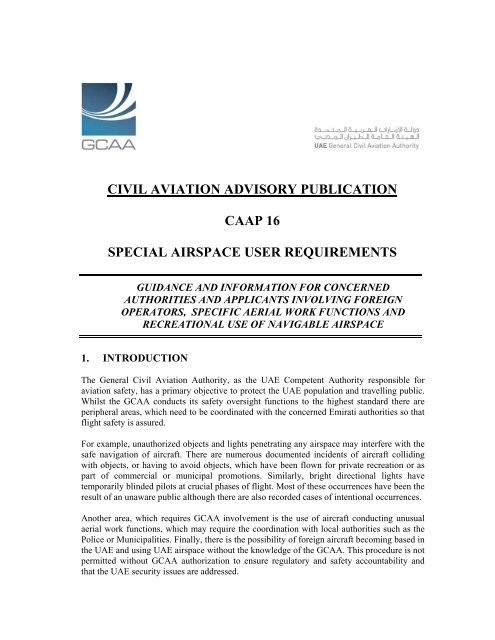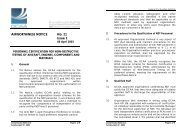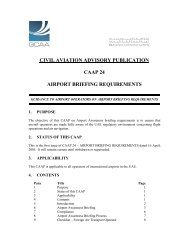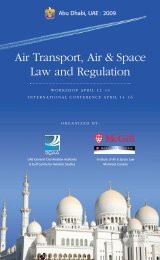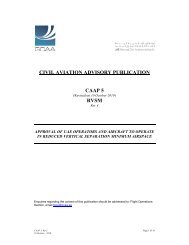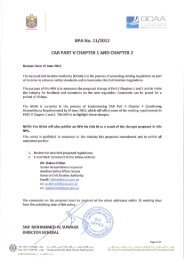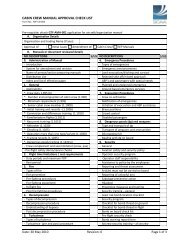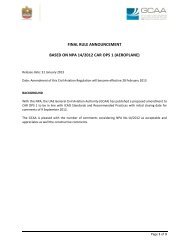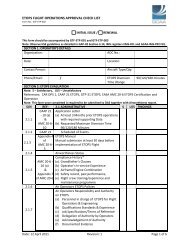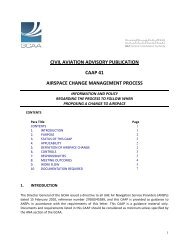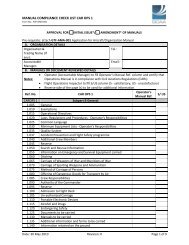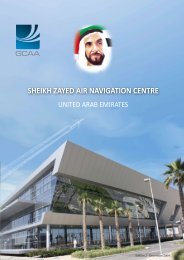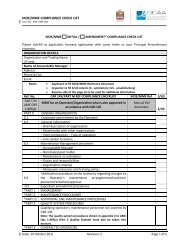civil aviation advisory publication caap 16 special airspace user ...
civil aviation advisory publication caap 16 special airspace user ...
civil aviation advisory publication caap 16 special airspace user ...
Create successful ePaper yourself
Turn your PDF publications into a flip-book with our unique Google optimized e-Paper software.
CIVIL AVIATION ADVISORY PUBLICATION<br />
CAAP <strong>16</strong><br />
SPECIAL AIRSPACE USER REQUIREMENTS<br />
GUIDANCE AND INFORMATION FOR CONCERNED<br />
AUTHORITIES AND APPLICANTS INVOLVING FOREIGN<br />
OPERATORS, SPECIFIC AERIAL WORK FUNCTIONS AND<br />
RECREATIONAL USE OF NAVIGABLE AIRSPACE<br />
1. INTRODUCTION<br />
The General Civil Aviation Authority, as the UAE Competent Authority responsible for<br />
<strong>aviation</strong> safety, has a primary objective to protect the UAE population and travelling public.<br />
Whilst the GCAA conducts its safety oversight functions to the highest standard there are<br />
peripheral areas, which need to be coordinated with the concerned Emirati authorities so that<br />
flight safety is assured.<br />
For example, unauthorized objects and lights penetrating any <strong>airspace</strong> may interfere with the<br />
safe navigation of aircraft. There are numerous documented incidents of aircraft colliding<br />
with objects, or having to avoid objects, which have been flown for private recreation or as<br />
part of commercial or municipal promotions. Similarly, bright directional lights have<br />
temporarily blinded pilots at crucial phases of flight. Most of these occurrences have been the<br />
result of an unaware public although there are also recorded cases of intentional occurrences.<br />
Another area, which requires GCAA involvement is the use of aircraft conducting unusual<br />
aerial work functions, which may require the coordination with local authorities such as the<br />
Police or Municipalities. Finally, there is the possibility of foreign aircraft becoming based in<br />
the UAE and using UAE <strong>airspace</strong> without the knowledge of the GCAA. This procedure is not<br />
permitted without GCAA authorization to ensure regulatory and safety accountability and<br />
that the UAE security issues are addressed.
All of the above activities require the coordination of the appropriate Emirate Department of<br />
Civil Aviation (DCA). The purpose of this CAAP is to inform the general public, promoters,<br />
municipalities and concerned authorities of the types of hazards affecting navigable <strong>airspace</strong>,<br />
the permitted <strong>airspace</strong> activities, as well as the notification mechanism for approval of these<br />
activities.<br />
2. STATUS OF THIS CAAP<br />
This is the first issue of CAAP <strong>16</strong>, Special Airspace User Requirements, dated 15 March,<br />
2004. It will remain current until withdrawn or superseded.<br />
3. APPLICABILITY<br />
This CAAP applies to:<br />
3.1 Infringement of Airspace<br />
(a)<br />
Free Flight Objects<br />
(i)<br />
(ii)<br />
Balloons, including meteorological, promotional or cluster balloons<br />
Model aircraft and drones<br />
(b)<br />
Tethered objects<br />
(i)<br />
(ii)<br />
Balloons, including advertising balloons<br />
Kites<br />
(iii) Parasail and derivatives<br />
(c)<br />
Other objects or lights<br />
(i)<br />
(ii)<br />
Rockets<br />
Pyrotechnic displays<br />
(iii) Laser and searchlights<br />
(d)<br />
(e)<br />
(f)<br />
Small arms weapons ranges<br />
Blasting activities<br />
Radio interference<br />
3.2 Specific Aerial Work Functions<br />
(a)<br />
Operations by any operator involving:<br />
(i) Operations within a built up area.<br />
CAAP <strong>16</strong><br />
15 March, 2004<br />
2
(ii)<br />
Sightseeing flights<br />
(iii) Ferry or training flights;<br />
(iv) Aerial work operations, including:<br />
(1) Fire suppression<br />
(2) Agricultural operations<br />
(3) External load operations<br />
(4) Aerial photography and survey<br />
(5) Aerial reconnaissance<br />
(6) Aerial advertising<br />
(7) Air shows and aerial demonstrations (refer also to CAAP 15)<br />
(8) Carriage and dropping of parachutists (operator of aircraft)<br />
(9) Navigation aid calibration<br />
(10) Other activities as determined by the GCAA.<br />
(v)<br />
Operations not stated in AOC Operations Specifications or Authority.<br />
(b)<br />
Operations by Foreign aircraft involving any aerial work function.<br />
3.3 Foreign Aircraft/Operators Based, Or Proposed To Be Based, In The UAE<br />
Operations by foreign operators involving the basing, or proposed basing in the UAE for any<br />
purpose.<br />
4. CONTENTS<br />
Para Title Page No.<br />
1 Introduction 1<br />
2 Status Of this CAAP 2<br />
3 Applicability 2<br />
4 Contents 3<br />
5 Legal Requirements 4<br />
6 Application process 5<br />
7 Prescribed Terms 7<br />
8 Checklist 13<br />
5. LEGAL REQUIREMENTS<br />
CAAP <strong>16</strong><br />
15 March, 2004<br />
3
5.1 General<br />
The UAE Civil Aviation Law (CAL) authorizes the GCAA as the Competent Authority in<br />
respect to the final authorization related to this CAAP. In addition to the following, the CAL<br />
and Civil Aviation Regulations (CAR) make provision for aerial photography and pilotless<br />
aircraft.<br />
5.2 Legislation Regarding Infringement of Airspace<br />
The UAE CARs, Part III, Chapter 7, state;<br />
“7.1 No person, or organization for which that person is responsible, shall permit any man<br />
made object to infringe above a height of 200 feet above ground level within 8 km of<br />
an airport, or 300 feet above ground level elsewhere within the UAE FIR, unless<br />
approved by the appropriate Emirate Department of Civil Aviation.<br />
An object may be, but is not limited, to any of the following;<br />
(a)<br />
(b)<br />
(c)<br />
(d)<br />
(e)<br />
(f)<br />
(g)<br />
Free and tethered unmanned balloons<br />
Kites<br />
Model aircraft or drones<br />
Rockets or pyrotechnics<br />
Para-sails or para-gliders tethered to a land or sea vehicle<br />
Ballistics<br />
Buildings or cranes<br />
7.2 No person, or organization for which that person is responsible, shall project, or cause<br />
to be projected, a directed bright light source into navigable <strong>airspace</strong> in such a manner<br />
that a hazard to <strong>aviation</strong> safety, damage to an aircraft or injury to persons on board the<br />
aircraft takes place. A directed light source may be, but is not limited, to any of the<br />
following;<br />
(a)<br />
(b)<br />
Laser lights<br />
Searchlights<br />
7.3 A pilot-in-command shall not intentionally operate an aircraft into a beam from a<br />
directed bright light source or into an area where such a beam is being projected.<br />
7.4 No person, or organization for which that person is responsible, shall knowingly permit<br />
any radio transmitting device interfere with safe navigation of aircraft.”<br />
CAAP <strong>16</strong><br />
15 March, 2004<br />
4
7.5 No person shall attempt to communicate with an aircraft, or interfere with a published<br />
ground to air <strong>aviation</strong> radio frequency, unless permitted by the aircraft operator, or<br />
authorized by the Emirate Department of Civil Aviation or GCAA.”<br />
5.3 Legislation Regarding Aerial Work Operations<br />
CAR Part IV, Subpart B, parargraph 1.2.2 states:<br />
“Unless otherwise specifically authorized by the GCAA, the following operations are<br />
categorized as commercial operations”. Therefore any UAE operator proposing to conduct<br />
any aerial work functions must hold an AOC and a foreign operator must be specifically<br />
authorized by the State of Registry.<br />
5.4 Legislation Regarding Foreign Aircraft<br />
CAR Part III, Chapter 6 states the general requirements for foreign operators. In addition:<br />
“6.10.1 Foreign aircraft of any category are not permitted to be based in the UAE<br />
without authority. An aircraft shall be deemed to be based in the UAE when, in<br />
the opinion of the GCAA, its principal operations, administration and/or<br />
maintenance facilities are located in the UAE in other than a temporary manner.<br />
Maintenance organisations based in the UAE shall be approved by the GCAA.<br />
6.10.2 The GCAA may issue a <strong>special</strong> flight authorization for foreign aircraft subject to<br />
any conditions and limitations that the GCAA considers necessary for safe<br />
operations in UAE <strong>airspace</strong>.”<br />
5.5 Legislative Compliance<br />
Operators, organizations, or promoters, which are affected by any of the above legislation,<br />
should immediately notify the appropriate Emirate Department of Civil Aviation (Attn<br />
Operations Manager), or the GCAA for those Emirates without a DCA.<br />
5.6 Legislative Approval<br />
Any of the operations stated in Section 3 – Applicability require the authorization of the<br />
appropriate Emirate Department of Civil Aviation (DCA) and in accordance with the terms<br />
prescribed by the GCAA. This legislation will be enforceable and there will be penalty<br />
provisions for non compliance.<br />
6. APPLICATION PROCESS<br />
6.1 Procedure<br />
All applications, regardless if submitted by an operator, representative, organiziser, promoter<br />
or concerned autyhority, shall be sent directly to the Department of Civil Aviation of the<br />
appropriate Emirate. The only exception to this procedure is for those applications involving<br />
the Ajman or Umm Al Qwain Emirate.<br />
CAAP <strong>16</strong><br />
15 March, 2004<br />
5
The DCA is the controlling authority of any application and should liaise with authorities,<br />
which may have some involvement with the conduct of the operation. For example, heavy lift<br />
or recreational operations in a city environment should have the approval of the police and<br />
municipality, whilst low level operations near a sensitive area or animal sanctuary may<br />
involve a specific Emirate authority. After due consultation with concerned authorities, and<br />
only when the DCA is satisfied that the operation can proceed, the application will be sent to<br />
the GCAA as the final authority. The GCAA will determine the legal implications and<br />
coordinate with the General Head Quarters (GHQ). Once a no objection has been received,<br />
the GCAA will issue the final authority (or rejection) to the applicant giving any terms for the<br />
operation.<br />
6.2 Summary<br />
APPLICATION<br />
Note: For Ajman & Umm Al Qwain<br />
the GCAA will contact all<br />
concerned Authorities<br />
DCA<br />
OF APPLICABLE<br />
EMIRATE<br />
Police<br />
Municipality<br />
ATC<br />
CONCERNED<br />
AUTHORITIES FOR<br />
NO OBJECTION<br />
Ministry of Interior<br />
DCA<br />
For initial approval<br />
GHQ no objection<br />
GCAA<br />
For final approval<br />
& additional terms<br />
APPLICANT<br />
Copy to DCA<br />
Note:<br />
The initial approval from the DCA must be sent only to the GCAA for final<br />
authorization.<br />
7. PRESCRIBED TERMS<br />
CAAP <strong>16</strong><br />
15 March, 2004<br />
6
7.1 General<br />
The GCAA may approve an operation in accordance with prescribed terms. These terms are<br />
based on international best practice and are in keeping with the objective of public safety and<br />
national interest. The following are the standard terms although they may be altered as<br />
required.<br />
7.2 Free Flight Objects - Balloons, Model aircraft and Drones<br />
7.2.1 Balloons. Unmanned balloons, including meteorological, promotional or<br />
cluster balloons, may be flown below a height of 200 feet above ground level within 8 km of<br />
a promulgated airport, or below a height of 300 feet above ground level elsewhere within the<br />
UAE FIR, without authorization. To fly above these heights within the stated distances from<br />
promulgated airports requires approval by the appropriate Emirate Department of Civil<br />
Aviation. The GCAA prescribed terms are:<br />
(a)<br />
(b)<br />
The DCA shall be satisfied that the balloon trajectory for the type of balloon<br />
under the prevailing conditions will not interfere with aircraft arrivals, departures<br />
or transits at any airport within the Emirate or adjoining Emirate.<br />
The concerned authorities shall be notified.<br />
7.2.2 Model Aircraft and Drones. Model aircraft and drones may be flown<br />
below a height of 200 feet above ground level within 8 km of a promulgated airport, or below<br />
a height of 300 feet above ground level elsewhere within the UAE FIR, without<br />
authorization. To fly above these heights within the stated distances from promulgated<br />
airports requires approval by the appropriate Emirate Department of Civil Aviation. The<br />
GCAA prescribed terms are:<br />
(a)<br />
(b)<br />
The DCA shall be satisfied that the trajectory of the aircraft will not interfere with<br />
aircraft arrivals, departures or transits at any airport within the Emirate or<br />
adjoining Emirate.<br />
The DCA shall ensure that the following minimum separation distances between<br />
spectators and model aircraft is maintained.<br />
Model Aircraft Type Model Aircraft Weight (Kgs.) Separation Distance<br />
Control Line any 15 metres<br />
Radio Controlled (Piston) less than 7 kgs<br />
30 metres<br />
more than 7 kgs.<br />
50 metres<br />
Radio Controlled (Turbine) any 75 metres<br />
Note:<br />
The DCA may add an additional separation distance for models of<br />
exceptional dimensions or performance.<br />
CAAP <strong>16</strong><br />
15 March, 2004<br />
7
(c)<br />
(d)<br />
The DCA shall ensure that the weather limits for model aircraft flying is a<br />
minimum visibility of 500 metres and a maximum wind strength of 25 knots.<br />
The concerned authorities shall be notified.<br />
Note:<br />
The Emirate DCA has the right to impose additional limits on model<br />
aircraft flying regardless of the above legislative requirements.<br />
7.3 Tethered Objects - Balloons, Kites, Parasails<br />
Balloons, kites and parasails may be flown below a height of 200 feet above ground level<br />
within 8 km of a promulgated airport, or below a height of 300 feet above ground level<br />
elsewhere within the UAE FIR, without authorization. To fly above these heights within the<br />
stated distances from promulgated airports requires approval by the appropriate Emirate<br />
Department of Civil Aviation. The GCAA prescribed terms are:<br />
(a)<br />
(b)<br />
The DCA shall be satisfied that the balloon, kites or parasail will not interfere<br />
with aircraft arrivals, departures or transits at any airport within the Emirate or<br />
adjoining Emirate.<br />
The concerned authorities shall be notified.<br />
Note:<br />
Para-sails or para-gliders include any aerofoil tethered to a land or sea<br />
vehicle.<br />
7.4 Rockets or pyrotechnics<br />
Rockets or pyrotechnics may be fired below a height of 200 feet above ground level within 8<br />
km of a promulgated airport, or below a height of 300 feet above ground level elsewhere<br />
within the UAE FIR, without authorization. To be fired above these heights within the stated<br />
distances from promulgated airports requires approval by the appropriate Emirate<br />
Department of Civil Aviation. The GCAA prescribed terms are:<br />
(a)<br />
(b)<br />
The DCA shall be satisfied that the rockets or pyrotechnics will not interfere with<br />
aircraft arrivals, departures or transits at any airport within the Emirate or<br />
adjoining Emirate.<br />
The concerned authorities shall be notified.<br />
Note:<br />
A NOTAM should be issued for pyrotechnic displays.<br />
7.5 Lasers, Searchlights Or Display Lights<br />
7.5.1 General. Laser means an acronym for light amplification by stimulated<br />
emission of radiation. A laser is a device that produces an intense, directional, coherent beam<br />
of visible or invisible light. The following approval criteria apply to the normal range of<br />
industrial, entertainment or experimental lasers of the order of 20 watts continuous-wave<br />
power.<br />
CAAP <strong>16</strong><br />
15 March, 2004<br />
8
More powerful machines (for example, satellite rangers), may need to be dealt with by the<br />
provision of restricted <strong>airspace</strong> and a requirement for the laser operator to have observers to<br />
check for positive clearance from over flying aircraft. All analysis of the hazards associated<br />
with the use of lasers has been based on the criteria normally applied for public risk (for<br />
example, the consideration of the chance of physical injury to a person directly observing a<br />
laser beam). Aviation factors such as possible damage to aircraft equipment have not been<br />
able to be quantified, and are not included.<br />
7.5.2 The operation of searchlight, laser or other powerful directed light sources may<br />
be approved by the DCA provided that:<br />
(a)<br />
(b)<br />
(c)<br />
The DCA shall be satisfied that the lights will not interfere with aircraft arrivals,<br />
departures or transits at any airport within the Emirate or adjoining Emirate.<br />
The concerned authorities shall be notified.<br />
A searchlight shall not:<br />
(i)<br />
(ii)<br />
(iii)<br />
be operated within five kilometres of an aerodrome;<br />
be directed at an aircraft; and<br />
be directed below an angle 45° to the horizontal.<br />
(d)<br />
(e)<br />
(f)<br />
A laser shall not be used within the Laser Beam Free, Critical Flight and<br />
Sensitive Flight Zones as described below.<br />
The light operator has been instructed to inform the nearest air traffic control<br />
authority of the format and timing of the light display and of a telephone number<br />
for contact during the display.<br />
The operator is informed that the DCA reserves the right to have the light<br />
extinguished at any time if it is considered that its continued operation is likely to<br />
endanger the safe operation of aircraft.<br />
Note1:<br />
A NOTAM should be issued for laser and searchlight displays.<br />
7.5.3 Laser Zones. The following guidance material from ICAO Document 9815<br />
AN/447 Manual on Laser Emitters and Flight Safety should be used as a reference by the<br />
DCA.<br />
(a)<br />
Laser-beam Free Flight Zone (LFFZ)<br />
Airspace in the immediate proximity of the airport, up to and including 2,000 feet<br />
AGL, extending 2 NM in all directions measured from the runway centreline.<br />
Additionally, the LFZ includes a 3 NM extension, 2,500 feet each side of the<br />
extended runway centreline, up to 2,000' AGL of each useable runway surface.<br />
The level of laser light is restricted to a level that should not cause any visual<br />
disruption. Refer to Figure 1.<br />
CAAP <strong>16</strong><br />
15 March, 2004<br />
9
(b)<br />
Laser-beam Critical Flight Zone (LCFZ)<br />
Airspace within a 10 NM radius of the airport reference point, up to and<br />
including 10,000 feet AGL, where a level of laser light is restricted to avoid flash<br />
blindness or after-image effects. Refer to Figures 2 and 3.<br />
(c)<br />
Laser-beam Sensitive Flight Zone (LSFZ)<br />
Airspace outside the LFFZ and LCFZ where the irradiance is not to exceed 100<br />
W/cm unless some form of mitigation is applied. The LSFZ need not necessarily<br />
be contiguous with the other flight zones. that authorities (e.g., DCAs, military)<br />
have identified that must be protected from the potential effects of laser emissions.<br />
Refer to Figures 2 and 3.<br />
(d)<br />
Normal Flight Zones (NFZ)<br />
Airspace not defined as LFFZ, LCFZ or LSFZ. The NFZ must be protected from<br />
laser radiation capable of causing biological damage to the eye.<br />
FIGURE 1<br />
MULTIPLE RUNWAY LASER-BEAM FREE FLIGHT ZONE<br />
(LFFZ)<br />
CAAP <strong>16</strong><br />
15 March, 2004<br />
10
To be determined by DCA<br />
FIGURE 2<br />
PROTECTED LASER-BEAM FLIGHT ZONES<br />
** To be determined FIGURE 3<br />
MAXIMUM IRRADIANCE LEVELS<br />
CAAP <strong>16</strong><br />
15 March, 2004<br />
11
7.6 Small Arms Weapons Ranges<br />
The safety areas and distances quoted in this Section do not relate to <strong>aviation</strong> activities in<br />
particular, but are the same general standards used to protect members of the public near a<br />
weapons range. Further, they relate to open ranges only. Where baffling or anti-ricochet<br />
devices are used, safety areas may be reduced. Such cases should be referred to the GCAA<br />
for consideration.<br />
(a)<br />
(b)<br />
(c)<br />
(d)<br />
(e)<br />
The DCA shall be satisfied that aircraft, airborne or on the ground, should not be<br />
exposed to damage from bullets, shot or pellets.<br />
The DCA shall ensure that the safety zones associated with small arms weapons<br />
ranges shall not penetrate any aerodrome obstacle limitation surfaces.<br />
The concerned authorities shall be notified.<br />
The DCA shall apply to the area to be promulgated as a Danger Area in the AIP.<br />
The safety area shall be a circle of 2000 metres from the perimeter of the smalls<br />
arms range and the applicable safety height shall be 500 feet above ground level<br />
(AGL).<br />
Note:<br />
DCAs should determine if restrictions need to be applied to aircraft<br />
operations in the vicinity of aerodromes near such ranges.<br />
CAAP <strong>16</strong><br />
15 March, 2004<br />
12
8. CHECKLIST<br />
APPLICANT DETAILS<br />
Name of Applicant<br />
Contact Numbers of Applicant<br />
Name of accountable person responsible for proposed operation<br />
Contact Numbers of responsible person<br />
TYPE OF OPERATION<br />
Infringement of <strong>airspace</strong><br />
Specific Aerial work Function<br />
Basin of Foreign Operator<br />
FOR AIRSPACE INFRINGEMENT<br />
Type of Activity<br />
Area of operation<br />
Height of operation<br />
Dates & timings<br />
Insurance<br />
Justification<br />
FOR RECREATIONAL AIRCRAFT<br />
Type and number of aircraft<br />
Area of operation<br />
Height of operation<br />
Dates & timings<br />
Insurance<br />
Justification<br />
FOR AERIAL WORK AIRCRAFT<br />
Type, model and number of aircraft<br />
State of Registry and state of Operator<br />
Leasing arrangement<br />
Area of operation<br />
Height of operation<br />
Dates & timings<br />
Insurance<br />
AOC & aircraft documentation<br />
No objection from State of Registry for foreign aircraft<br />
Justification (including contractual agreement)<br />
Use of photographic apparatus<br />
FOR FOREIGN OPERATORS TO BE BASED<br />
Type, model and number of aircraft<br />
State of Registry<br />
Leasing arrangement<br />
Maintenance facilities<br />
Insurance<br />
AOC & aircraft documentation<br />
No objection from State of Registry<br />
Justification<br />
CAAP <strong>16</strong><br />
15 March, 2004<br />
13
DCA APPROVAL CHECKLIST<br />
All info & documentation received<br />
No Objection From Concerned Authorities<br />
Police for crowd control, blockage of streets<br />
Municipality for low level city operations<br />
Owner of building or land for tethering or landing<br />
Local Government for sensitive areas<br />
Local ATC for <strong>airspace</strong> use<br />
Ministry for Interior for sensitive operations<br />
Note: Failure to respond in given time should be acceptance of no objection<br />
DCA Approval<br />
Name: Appointment: Signature: Date:<br />
Note:<br />
Attach copies of documents to this form and submit to GCAA<br />
No Objection From GHQ<br />
Legal implications determined<br />
Waiver issued<br />
Terms determined<br />
GCAA Authorization<br />
GCCA APPROVAL CHECKLIST<br />
Name: Appointment: Signature: Date:<br />
Final letter of authorization sent to applicant<br />
Copy to DCA<br />
CAAP <strong>16</strong><br />
15 March, 2004<br />
14


